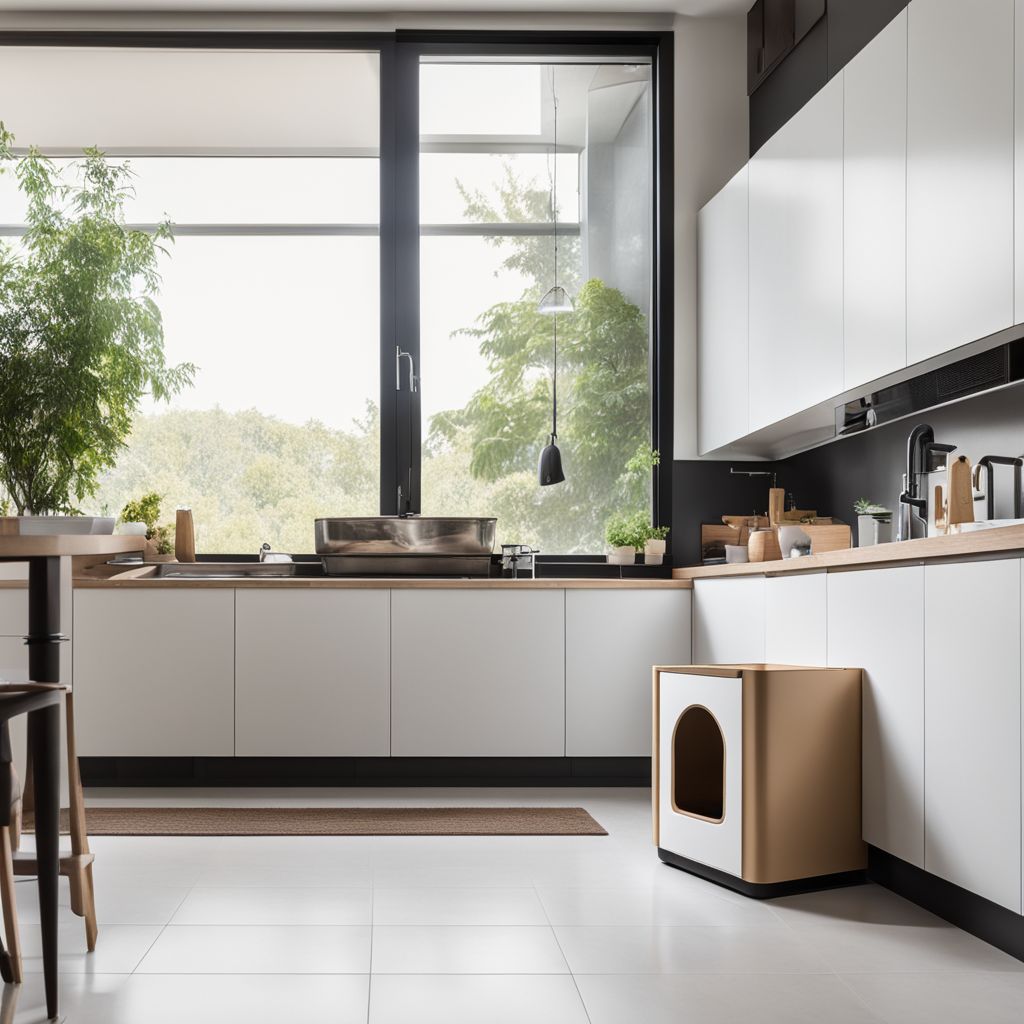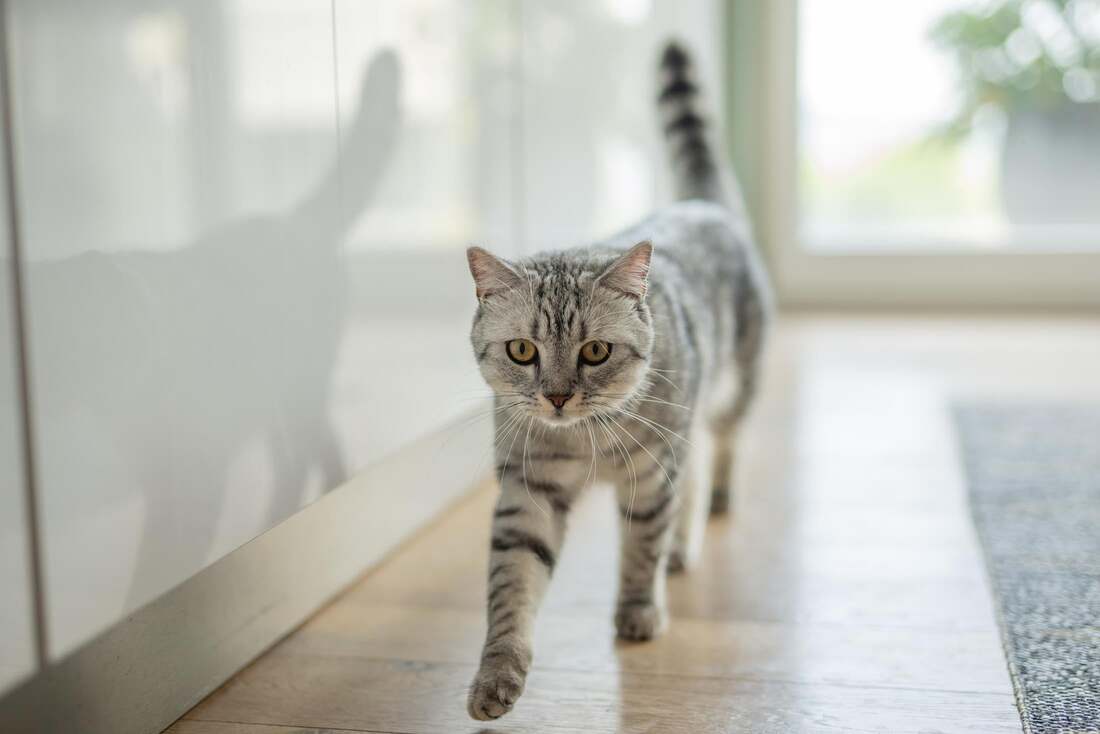Have you ever considered putting the litter box in the kitchen? The idea may seem practical at first, but many cat owners are unsure whether this is hygienically acceptable.
In principle, it is possible to place the litter box in the kitchen as long as you pay attention to cleanliness and the cat does not feel disturbed.
In this article, we address hygiene concerns, discuss the optimal number of litter boxes, give tips on how to combat odors, and show alternatives and innovative solutions.
Hygienic concerns: Is the litter box in the kitchen really clean?

It's understandable that you're concerned about whether a litter box in the kitchen is hygienic. After all, the kitchen is where food is prepared.
Cat litter can contain bacteria and parasites that are spread through the air when the cat uses the litter box or when it is cleaned.
To ensure hygiene, here are some measures:
- Clean the litter box daily
- Change litter regularly
- Use a scoop that is only used for the litter box
It is important to be aware that cats are very clean animals. They may feel disturbed if their litter box is near food and drink. The cat's well-being can suffer if it feels like it is being watched while going to the toilet. Therefore, the litter box should be in a quiet place . Being close to food can also be problematic for people. There is a risk that food will come into contact with cat hair or litter. If there is no other option than to place the litter box in the kitchen, you should move it as far away from eating areas as possible . In summary, placing the litter box in the kitchen is not ideal for hygiene reasons. Make sure it is clean to minimize risks.
Number of litter boxes: Is the kitchen the right place?

Are you wondering how many litter boxes you need and whether the kitchen is the right place for them? The number of litter boxes should always be at least as high as the number of cats you have plus one. This means that if you have one cat you should have two boxes, if you have two cats you should have three, and so on.
The reason for the additional toilet is that cats like to separate their business. They often use one toilet for urination and another for their excrement. This is because cleanliness is very important for cats.
But is the kitchen the right place for one of these toilets? The kitchen is often seen as a convenient place because it is easy to clean. But there are some important points to consider:
- The proximity of food and toilet is not ideal for cats
- Odors can be unpleasant and affect the food
- There is a risk that litter will come into contact with food areas
Cats need a quiet and undisturbed place to go to the toilet. The kitchen is often busy and it can be stressful for the cat if it feels like it is being watched while going to the toilet.
It is also important that the litter boxes are not hidden or in spaces that are too small. The litter boxes should be open and easily accessible so that your cat does not feel cramped. This promotes well-being and prevents problems when going to the toilet.
If you have multiple cats, it's especially important to have separate litter boxes. This reduces tension and ensures that each cat has its own stress-free area.
In summary, the kitchen is not the optimal place for a litter box. There are better places in your home that are more suitable for your cat's needs and for hygiene. Make sure you have the right number of litter boxes and place them in quiet, cat-friendly places.
Odor control: How to keep the kitchen fresh

If you have decided to place the litter box in the kitchen, odor control is an important issue. After all, you want your kitchen to stay fresh and not have any unpleasant smells spreading.
Daily cleaning of the litter box is essential. Remove your cat's droppings regularly and make sure the litter stays clean.
There are various types of litter that can help to bind odors. Particularly effective are:
- Clumping litter made from plant fibers.
- Litter with activated carbon filter.
- Perfumed litter , although you should pay attention to whether your cat accepts it.
In addition to the choice of litter, ventilation in the kitchen is crucial. Make sure there is enough fresh air by regularly opening the windows to get rid of odors.
Another way to minimize odors is to use odor-eliminating litter boxes or litter box cabinets that can be stylishly integrated into your kitchen decor.
Also remember to clean the litter box regularly . Once a week you should thoroughly wash the litter box with hot water and a neutral cleaner.
To neutralize odors, rinsing with vinegar can be a good method. Make sure to rinse with plenty of clean water afterwards so that no vinegar residue remains.
Finally, it is advisable to fill the litter box with enough litter - at least five centimeters high . This not only makes cleaning easier, but also helps to bind odors and ensure your cat's well-being.
Alternatives to the kitchen: Where else can the litter box be placed

If the kitchen is not the ideal place for the litter box, the question arises: where is a better place? There are several alternatives that may be better suited to both the cat and the home decor.
A popular place is the bathroom. It is often quiet here and the tiles are easy to clean. Make sure the litter box is not right next to the toilet or shower so that the cat has enough privacy.
Here are some advantages of the bathroom as a location:
- It is easy to clean.
- There is often already good ventilation.
- The cat has more privacy.
Another option is the living room, but with one caveat: the litter box should be hidden in a corner or behind a piece of furniture. This way it remains invisible to guests and your cat doesn't feel like the center of attention.
Above all, the litter box should be in a place that is always accessible . Avoid places that may be temporarily inaccessible due to doors or other barriers.
Some cat owners have found creative solutions, such as hiding the litter box in a closet or chest. These options can be especially helpful in small apartments where every square inch counts.
Ultimately, it is important to choose a place where your cat feels comfortable and which is also hygienic. Try different places and see where your cat feels most comfortable.
Solve the litter box problem with Flappies intelligent cat flap

Flappie has developed a smart cat flap that solves the problem of unwanted prey in the house. Using artificial intelligence, the flap detects if your cat comes home with prey and then prevents entry. This keeps your home clean and free of dead animals that your cat may bring with it. This innovation makes the kitchen litter box less of a problem, as it reduces the likelihood of your cat bringing prey into the house and hiding it there.
By using Flappies cat flap you can enjoy several benefits:
- Selective access control that only allows your cat without prey to enter
- Prey detection through a camera that also works at night
- An app that notifies you and allows you to control the cat flap remotely
Visit https://flappie.ch to learn more about this innovative solution and how it can help you solve your kitchen litter box problem.
Frequently Asked Questions
Where should you put the litter box?
The litter box should be in a quiet and undisturbed place that is always accessible. The kitchen is not ideal for hygiene reasons. Alternatives are the bathroom, as it is easy to clean and often quiet, or the living room, where the litter box should be hidden. It is important that the cat does not feel watched when it goes to the toilet and that it has enough privacy. Creative solutions such as hiding it in a cupboard can be useful in small apartments.
What can you do to stop the litter box from smelling?
To combat odors, you should clean the litter box daily and change the litter regularly. Different types of litter, such as clumping litter made from plant fibers, litter with an activated carbon filter or scented litter, can help to bind odors. The kitchen should be aired regularly to let in fresh air. Odor-removing litter boxes or litter cabinets can also be useful. A complete weekly cleaning of the litter box with hot water and neutral cleaner is also recommended. Vinegar can help neutralize odors when washing it out, but it should be rinsed thoroughly with clean water afterwards. The litter box should also be filled with enough litter, at least five centimeters deep.
How many litter boxes for 1 cat?
You should have at least two litter boxes for one cat. The rule of thumb is to choose the number of litter boxes at least equal to the number of cats you have plus one. This allows cats to separate their business, as they often use one box for urination and another for their defecation.





Share:
Clicker Training: Tricks for Cats Made Easy
2 Litter Box: How many litter boxes are necessary?